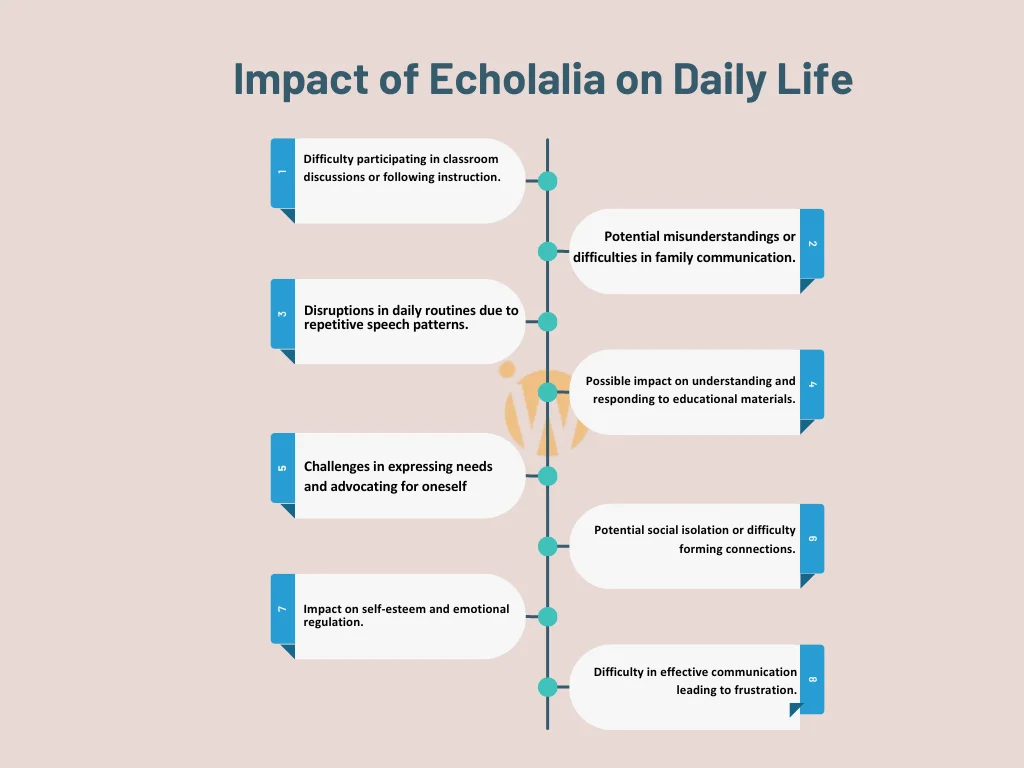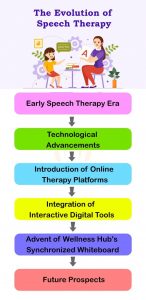Echolalia in Language Development: Strategies for ASD Support
By Rajini D
Last Updated: December 1, 2023
Echolalia is a fascinating phenomenon related to language and communication. It involves the repetition of words, phrases, or sentences spoken by others. This can happen immediately after hearing the words or after a delay.
Echolalia is often observed in individuals with autism spectrum disorder (ASD), but it can also occur in other conditions such as Tourette syndrome, schizophrenia, and certain neurological disorders. It plays a role in language development and can be observed in both typical language development and in individuals with Autism Spectrum Disorder (ASD).
Relevance in Language Development
Echolalia can play a major role in language development, especially in typical language acquisition. Mimicking and repeating words help children to experiment with new words and phrases.
Typical Development:
In typical language development, echolalia is often a natural and temporary phase in early childhood. It can serve as a way for children to practice and reinforce language skills. Mimicking and repeating what they hear helps them grasp the structure and meaning of words and phrases. It helps them to know how language works.
Through echolalia, children internalize language patterns and structures by repeating what they hear. This internalization is crucial for the development of expressive language skills. It helps children grasp the rules of grammar, syntax, and semantics in a practical and hands-on way. Echolalia also helps in building vocabulary, social interaction, and communication.
ASD (Autism Spectrum Disorder):
Echolalia is frequently observed in individuals with ASD. It can manifest in different forms, including immediate echolalia (immediately repeating what is heard) and delayed echolalia (repeating after a period of time).
Types of Echolalia:
| Feature | Immediate Echolalia | Delayed Echolalia |
|---|---|---|
| Timing | Immediate repetition of words or phrases just heard. | Repetition of previously heard words or phrases after a delay. |
| Context | Often occurs in response to a recent stimulus or conversation. | Can happen at any time, even when not directly prompted by the current context. |
| Function | Often serves a communicative or interactive purpose in the moment. | May serve various functions, including self-soothing, expression, or processing information. |
| Speech Development | Can be part of normal language development in early childhood. | More commonly associated with neurodevelopmental disorders, such as autism spectrum disorder. |
| Awareness | May reflect immediate understanding or repetition without deep comprehension. | Can indicate a strong memory recall but may not always demonstrate full comprehension. |
| Examples | – Child hears, “Do you want juice?” and responds, “Do you want juice?” – Person with Tourette’s syndrome repeating others’ words involuntarily. | – Child watches a video, hears a line, and repeats it later, seemingly out of context. – Individual with Alzheimer’s disease repeating phrases from earlier conversations. |
Echolalia manifests in different types, and understanding them helps in recognizing their role in typical language development. Here are the main types of echolalia and their roles:
Immediate Echolalia:
Definition:
The immediate repetition of words, phrases, or sentences right after they are heard is called as Immediate Echolalia. This occurs when a person repeats something right after hearing it. It could be a way for them to process or make sense of the language they’ve just heard.
Role in Typical Development:
In typical language development, immediate echolalia is common in early childhood. Children use it as a way to practice and internalize language. It helps them experiment with sounds, intonation, and the structure of language. This form of echolalia is often a natural part of language acquisition.
Delayed Echolalia:
Definition:
Repetition of words, phrases, or sentences after a delay, which could range from minutes to hours or even days, is called Delayed Echolalia. In this case, there’s a gap between hearing the words and repeating them. It could involve recalling a phrase heard earlier and using it in a relevant context.
Role in Typical Development:
Delayed echolalia is less common in typical development but can still be observed. Children may repeat phrases they’ve heard earlier as a way to remember, process, or integrate them into their own expressive language. It serves as a form of rehearsal and can contribute to the development of language skills.
While echolalia is a common and generally beneficial part of language development, it’s important to note that excessive or persistent echolalia, especially in atypical contexts, may be indicative of underlying communication challenges. In such cases, understanding the individual’s specific needs and providing targeted support, such as through speech and language therapy, can be valuable in fostering more effective communication skills.
Echolalia in different contexts:
Echolalia serves various purposes, and its interpretation can depend on the individual and context.
Communication:
For some individuals, echolalia is a way to communicate. They might use phrases they’ve heard as a means of expressing themselves. Echolalia aids in building vocabulary as children repeat and familiarize themselves with a variety of words and expressions. Exposure to diverse vocabulary through repetition contributes to the expansion of a child’s language repertoire. It’s a natural way for them to acquire and integrate new words into their communication.
Social Interaction:
It can also be a way to engage in social interaction. Repetition of familiar phrases may serve as a way to connect with others, even if the phrases are not used in a conventional manner. Echolalia, especially immediate echolalia, can serve as a tool for social interaction and communication. It allows children to participate in conversations, respond to others, and engage in social exchanges. This social aspect of language is crucial for developing effective communication skills.
Learning and Processing:
In some cases, echolalia is a part of the learning process. Individuals may use repetition as a way to practice and understand language. Echolalia may be a form of scripting where individuals repeat phrases from movies, books, or previous interactions as a way to navigate social situations.
Understanding echolalia is crucial for caregivers, educators, and healthcare professionals working with individuals who exhibit this behavior. It provides insights into the individual’s communication style and can guide interventions tailored to their needs.

Assessment and Diagnosis of Echolalia:
Criteria for Assessing Echolalia:
Frequency and Duration:
- Assess how often and for how long echolalic behaviors occur.
Contextual Analysis:
- Examine the situations in which echolalia occurs to understand its communicative function.
Types of Echolalia:
- Differentiate between immediate and delayed echolalia and observe if the repetition is verbatim or modified.
Functional Analysis:
- Determine the purpose of echolalia, such as communication, self-regulation, or social interaction.
Tools and Methods:
Observational Analysis:
- Professionals may observe and analyze the individual’s language use in various contexts.
Communication Assessment:
- Standardized assessments can evaluate receptive and expressive language skills.
Functional Behavior Assessment (FBA):
- Functional behavior assessment helps identify the function of echolalia within specific contexts.
Intervention Strategies:
Therapeutic Approaches:
Applied Behaviour Analysis (ABA):
- Applied Behaviour Analysis (ABA) is a systematic approach to modifying behavior by breaking it down into smaller components.
Speech and Language Therapy:
- Speech and language therapy focuses on improving communication skills and reducing inappropriate echolalic behaviors.
Social Communication Interventions:
- Social communication interventions target social interaction and pragmatic language use.
Role of Speech and Language Therapy:
Functional Communication Training (FCT):
- Functional communication training teaches alternative, more functional ways to communicate needs and desires.
Scripting and Social Stories:
- Scripting and social stories use pre-learned scripts to teach appropriate responses in social situations.
Visual Supports:
- Visual support incorporates visual aids to enhance understanding and communication.
Case Studies:
Case 1:
Immediate Echolalia in a Child with ASD
- Assessment: Frequency and context analysis, FBA.
- Intervention: ABA-based strategies, FCT, and social communication interventions.
- Outcome: Reduced echolalic behaviors and improved functional communication.
Case 2:
Delayed Echolalia in a Teen with ADHD
- Assessment: Detailed analysis of delayed echolalia patterns, FBA.7
- Intervention: Speech and language therapy targeting pragmatic language skills.
- Outcome: Improved social communication and reduced reliance on delayed echolalia.
Supporting Individuals with Echolalia:
Practical Tips:
Provide Structured Environment:
- Clear routines and visual schedules can help individuals with echolalia.
Use Visual Supports:
- Visual cues and supports can enhance comprehension and communication.
Encourage Functional Communication:
- Reinforce the use of communication to express needs and desires.
Communication Strategies:
Modeling:
- Demonstrate appropriate language use and responses.
Prompting and Cueing:
- Use prompts to guide individuals toward more functional communication.
Positive Reinforcement:
- Reinforce positive communication behaviors to encourage their repetition.
Environmental Modifications:
Reduce Sensory Overload:
- Create a sensory-friendly environment to minimize potential triggers.
Clear Communication Expectations:
- Establish clear communication expectations in different settings.
Remember, individualized approaches are crucial, and collaboration among parents, educators, therapists, and other professionals is essential for effective support. Professional guidance should be sought for specific cases.
Echolalia – Communication:
In both typical development and ASD, the key is to recognize echolalia as a communicative tool and to facilitate the transition from repetitive language use to more functional and contextually appropriate communication. Speech and language therapy, along with other interventions, can be beneficial in addressing communication challenges associated with echolalia. Understanding echolalia in typical language development involves recognizing it as a phase that many children go through. It’s a tool for learning, practicing, and internalizing the complex patterns of language. Over time, as children develop more advanced language skills, the tendencies of echolalia typically decrease.
It’s important to note that while echolalia is a common and usually transient part of language development, persistent and atypical patterns of echolalia may be indicative of communication challenges, such as those seen in individuals with autism spectrum disorder (ASD). In such cases, a more nuanced approach, possibly involving speech and language therapy, may be beneficial to support effective communication.
Frequently Asked Questions
1. What is Echolalia and How Does It Relate to Language Development?
Echolalia is the repetition of words, phrases, or sentences spoken by others, either immediately after hearing them or after a delay. It plays a significant role in language development, particularly in children, as it helps them to practice and internalize language structures, aiding in the development of grammar, syntax, semantics, and vocabulary.
2. Is Echolalia Normal in Children’s Language Development?
Yes, in typical language development, echolalia is a natural and temporary phase in early childhood. It serves as a method for children to practice and reinforce language skills, helping them understand the structure and meaning of language.
3. How Does Echolalia Manifest in Individuals with Autism Spectrum Disorder (ASD)?
In individuals with ASD, echolalia often appears in two forms: immediate echolalia (repeating what is heard immediately) and delayed echolalia (repeating phrases after a period). It may serve various functions, such as communication, self-soothing, or processing information.
4. What Are the Intervention Strategies for Echolalia?
Intervention strategies include Applied Behaviour Analysis (ABA), Speech and Language Therapy, and Social Communication Interventions. These approaches focus on improving communication skills, reducing inappropriate echolalic behaviors, and teaching alternative, more functional ways to communicate.
5. How Can Caregivers and Educators Support Individuals with Echolalia?
Support can include providing a structured environment, using visual supports, encouraging functional communication, implementing modeling, prompting and cueing for appropriate language use, and reinforcing positive communication behaviors. It’s important to tailor these approaches to the individual’s specific needs.
About the Author:
Rajini Darugupally
M.Sc., Speech-Language Pathologist (9+ years of experience)
Rajini is a passionate and dedicated Speech-Language Pathologist with over 9+ years of experience, specializing in both developmental speech and language disorders in children and rehabilitation in adults. Currently, at Wellness Hub, she thrives in a team environment that values innovation, compassion, and achieving results for their clients.
Connect with Rajini to learn more about how she can help you or your loved one find their voice.
Book your Free Consultation Today
Parent/Caregiver Info:
Client’s Details:
* Error Message









